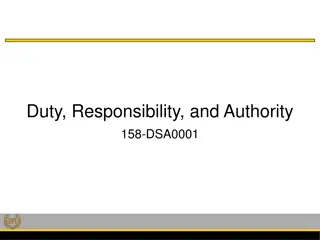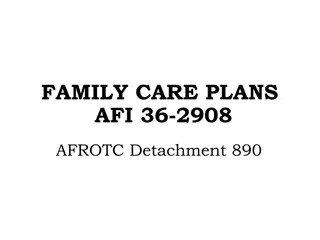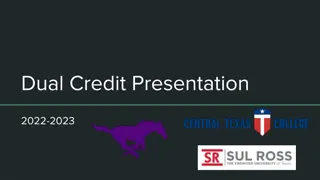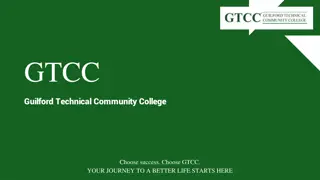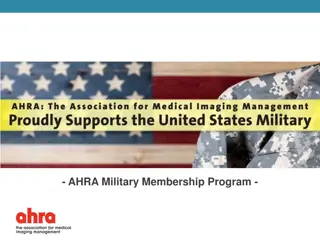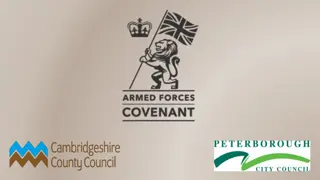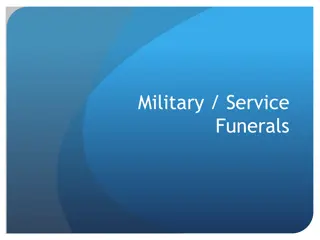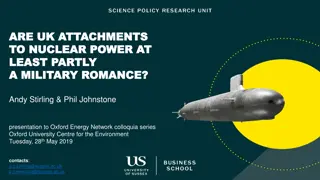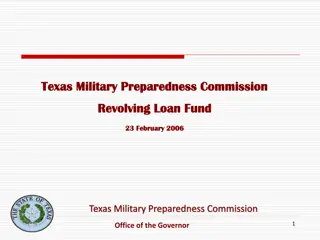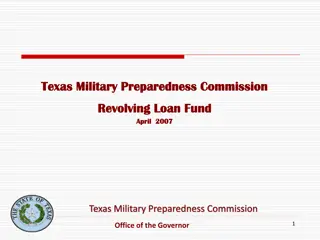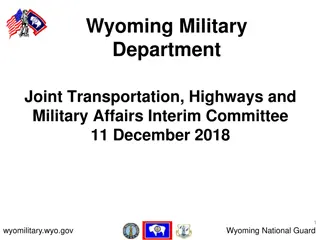
Exploring Military Options for College Access Program Students
Gain insights into various military branches and opportunities, tips for advising students interested in military careers, understand ROTC and academy application processes, and explore the Army, Navy, and Marines branches in detail with this informative session.
Download Presentation

Please find below an Image/Link to download the presentation.
The content on the website is provided AS IS for your information and personal use only. It may not be sold, licensed, or shared on other websites without obtaining consent from the author. If you encounter any issues during the download, it is possible that the publisher has removed the file from their server.
You are allowed to download the files provided on this website for personal or commercial use, subject to the condition that they are used lawfully. All files are the property of their respective owners.
The content on the website is provided AS IS for your information and personal use only. It may not be sold, licensed, or shared on other websites without obtaining consent from the author.
E N D
Presentation Transcript
EXPLORING MILITARY OPTIONS WITH COLLEGE ACCESS PROGRAM STUDENTS DARIANA ROYBAL | ADVISOR | EDUCATIONAL TALENT SEARCH JACOBOVARELA | DIRECTOR | VETERANS UPWARD BOUND COLORADO STATE UNIVERSITY PUEBLO
OUTCOMES After this presentation, attendees will Gain an understanding of various military branches and options Gain ideas and tips to help advise and support students who are interested in pursuing the military after high school Learn about military options that may help programs meet post-secondary matriculation objectives Gain awareness of ROTC and military academies application processes
MILITARY BRANCHES Generally, individuals who join the military are going to have opportunities for teamwork, physical growth, leadership development, travel, etc. However, each branch is different. Group Activity: Get into 4 groups Groups will be provided with descriptions/statements Working together, groups will match the descriptions/statements to the branch you think they belong to
MILITARY BRANCHES: ARMY Oldest branch of US Military Basic Combat Training (BCT) lasts 10 weeks and involves 3 phases. Army basic training is tough compared to many other branches, but not quite as tough as the Marines Majority of bases are in the US Popular jobs: Infantryman, Combat Engineer, Armor Crewman, etc.
MILITARY BRANCHES: NAVY Most base locations are on the coast Most jobs require time at sea may spend months at a time on a boat Basic training is at Naval Station Great Lakes, Illinois and lasts 8 weeks Jobs are grouped into these categories: aviation, construction, medical, administration, deck, technical, weapons specialist, engineering, & hull
MILITARY BRANCHES: MARINES Department of the Navy Basic training takes place at two locations: Parris Island, SC (Eastern US recruits) and San Diego, CA (Western US recruits) and lasts 14 weeks (3 phases) Marine boot camp is the toughest of all the branches First to fight when in war May be deployed for significant amounts of time
MILITARY BRANCHES: AIR FORCE Youngest and one of the most well-funded branches of the Military Tougher educational requirements to get in than Army, Navy, and Marines branches Most similar lifestyle to civilians compared to other branches Basic training lasts 8.5 weeks at LacklandAir Force base in San Antonio, TX Air Force basic training is not as physically demanding and focuses more on marching, Air Force customs, drills, etc. Airmen generally do not see combat (pilots are the exception)
MILITARY BRANCHES: COAST GUARD Smallest branch in the military Usually involves law enforcement, sea rescue, ocean safety, etc. Basic training takes place in Cape May, NJ and lasts 8 weeks Recruits choose from 23 jobs Can be transferred to Dept. of Navy during wars/conflict
MILITARY BRANCHES: NATIONAL GUARD & RESERVES Guard Reserves Army National Guard & Air National Guard Army, Navy, Marines, Air Force, & Coast Guard Reserve One weekend per month and 2+ weeks of training per year One weekend per month and 2+ weeks of training per year Basic training Basic Training Funded by federal government, but controlled by the state Role is to train/meet qualifications and be ready to for active duty when necessary Generally engages in domestic activities/concerns (i.e., disaster relief, etc.), but can be deployed if/when necessary Members usually hold civilian jobs and/or attend school while part-time Members usually hold civilian jobs and/or attend school while serving part-time
DISCUSSION Why should we be aware of some key points about each Military branch? What guidance have you provided to students interested in the Military in the past? What are some of the post-secondary options you are aware of within the Military?
OPTIONS WITHIN THE MILITARY Enlistment Reserves/Guard ROTC Military Academies Officer Candidate School
ENLISTMENT, GUARD, AND RESERVES Recruiter assists candidates to set up dates to do their physical (MEPS), take the ASVAB, select jobs, sign contract, etc. After the contract is signed, candidates will go to basic training. After basic training, they may need to complete further training for their job After basic training Those who enlist would begin their active duty wherever assigned Those who do guard or reserves would return home and serve on a part-time basis In order to enlist or serve in the guard or reserves, students must Be a U.S. Citizen or Permanent Resident Have a High School Diploma or GED Be at least 18 years old, or 17 with parent permission Take ASVAB test to determine eligibility for jobs Pass physical exam (MEPS) and meet weight limits (varies by branch) Cannot have chronic illnesses or be on long-term medication (i.e., inhalers, insulin, anti- depressants, etc.) Must pass drug test
BENEFITS OF ENLISTMENT, GUARD, & RESERVES Enlistment Guard/Reserves Career right out of high school, no experience required! Civilian life and part-time military life Leadership development Funding for education Funding for Education GI Bill (with activation) GI Bill Tuition Assistance Tuition Assistance Income (varies) Travel
RESERVE OFFICER TRAINING CORPS (ROTC) PROGRAMS College programs that prepare students to be officers in the military The military provides scholarships and a guaranteed post-secondary career in exchange for commitment to serve as an officer after college graduation Students apply for the scholarship during their senior year in high school (in most cases some branches have 2-3 year scholarships for college students as well) Each branch has their own ROTC program Army ROTC (AROTC) Navy ROTC (NROTC) Marine Corps ROTC (MCROTC) Air Force ROTC (AFROTC) ROTC programs are offered at various colleges/universities Requires research and early preparation!!
ROTC PROGRAMS SCHOLARSHIP INFORMATION Army ROTC Navy ROTC Marine Corps ROTC Air Force ROTC 4-year scholarship covers: Full tuition Book allowance Monthly stipend 4-year scholarship covers: Full tuition Partial fee coverage $750 book stipend Uniforms 4-year scholarship covers: Full tuition Partial fee coverage $750 book stipend Uniforms Type 1 Covers: 3-4 years full tuition Partial fee coverage Book stipend Type 2 Covers: 3-4 years of book stipends Fee coverage Up to $18,000 toward tuition per year Type 7 Covers: 3-4 years of book stipends Tuition capped at college s in-state tuition Deadline: Jan. 10thof senior year Deadline: End of Jan. of senior year Deadline: End of Jan. of senior year Deadline: December 1 Requirements: US Citizen Between 17-26 years old HS diploma Minimum of 920 on SAT or 19 on ACT Pass Army Physical Test Requirements: US Citizen Between 17-23 years old HS diploma Select tier 1-3 college major Minimum scores of 520 Math and 530 Verbal on SAT or 21 Math and 22 English on ACT Medically qualified by Navy standards Requirements: US Citizen Between 17-23 years old HS diploma Minimum of 100 on SAT or 22 on ACT Pass Marine Corps physical fitness test Minimum Armed Forces Qualification Test score of 74 Requirements: Minimum of 1180 on SAT or 26 on ACT Cumulative GPA of 3.0 or higher Scholarship interview Complete physical fitness assessment
MILITARY ACADEMIES Prepare students to serve as officers in the military Similar to ROTC, the military provides funding for college education and a guaranteed post-secondary career in exchange for commitment to serve as an officer after graduation from academies Military academies are highly selective and have lengthily application processes (7-18% acceptance rates) Requires congressional nomination The five academies are: US Military Academy (USMA) West Point, NY US Naval Academy (USNA) Annapolis, MD US Air Force Academy (USAFA) Colorado Springs, CO US Coast Guard Academy (USCGA) New London, CT US Merchant Marine Academy (USMMA) Kings Point, NY
POINTERS FOR APPLYING TO THE MILITARY ACADEMIES & ROTC SCHOLARSHIPS Students should prepare early!! Academics Maintain a good GPA throughout high school Take AP/IB, honors, dual/concurrent enrollment, etc. classes (only if prepared!!) Take SAT and/or ACT multiple times to boost scores (most ROTC scholarships and military academies super score!) Athletics Participate in varsity sports at school Involvement with club sports outside of school Leadership Leadership positions in school clubs/extra-curriculars/sports/community Volunteer/community service Know and plan for the deadlines Application processes for both, ROTC scholarships and military academies, require multiple steps that often must be complete in order An interview is a part of the Military academies application process Prepare for fitness tests and physicals Both ROTC scholarships and the military academies have physical and weight requirements Cannot have chronic illnesses or be on long-term medication (i.e., inhalers, insulin, anti-depressants, etc.) Must pass drug test, eye exam, and hearing test
OFFICER CANDIDATE SCHOOL Prepares qualified individuals to be Military officers Qualified individuals Have a bachelor s degree, or Are enlisted in the military and are transitioning to officer roles Each branch has their own OCS OCS lasts up to 12 weeks depending on the branch
BENEFITS OF ROTC, MILITARY ACADEMIES, & OCS ROTC Selective, but not as selective as military academies Intensive leadership development Funding for education Officer rank and pay after college Military Academies Fully-funded education Intensive leadership development Officer rank and pay after graduation from the academies Officer Candidate School Officer rank and pay upon completion of program
DISCUSSION Find a partner or small group to discuss How would you use this information with students who are interested in the military? How do you usually advise/guide students who are interested in the military?
SO NOW THE DATA We all want to be supportive of our students goals, but what about Post-Secondary Education Enrollment Post-Secondary Completion Although instances where TRIO students enlist immediately after high school graduation can negatively impact APR s, there are options that can actually help meet post-secondary matriculation objectives: ROTC scholarships last up to 4 years (students should complete a bachelor s within this time frame) Students who attend military academies must graduate with their bachelor s degrees within 4 years Students can apply to college and defer their enrollment until Spring to complete basic training for reserves/guard Students can choose to go to college before joining the military
OUR OBLIGATIONS TO STUDENTS Although our grant funds depend on our APRs, we still have an obligation to help students be successful Not all students are prepared for college after high school Is it better to send students to college to meet objectives, or support them to make logical decisions about their futures? Avoiding unnecessary debt Military options can be more fitting for students
ADVISING STUDENTS WHO ARE INTERESTED IN THE MILITARY Tips: Help students understand the different options they have in and outside of the military Have them do lots of research! Make sure they understand that the military is a serious commitment Students should try to gain as much information as possible on jobs, branches, requirements, various military options, etc. Help them study and prepare for the ASVAB and/or the SAT/ACT (if interested in ROTC/military academies) Be honest, upfront, and unbiased Help students understand the demands of military service No matter which option students choose, they usually will be signing up for an 8-year minimum commitment (x years active duty, and x years inactive/reserves, totaling to 8 years) Focus on the student, and don t get blinded by the data!!
THANK YOU!! Dariana Roybal TRIO Educational Talent Search Colorado State University-Pueblo dariana.roybal@csupueblo.edu JacoboVarela TRIO Veterans Upward Bound Colorado State University-Pueblo jacobo.varela@csupueblo.edu
SOURCES Military.com. (n.d.). Everything You Need To Know About Joining The Guard and Reserve. Retrieved from https://www.military.com/join-armed-forces/guard-and-reserve-faqs.html. Military.com. (n.d.). Learn About the Armed Forces Service Academies. Retrieved from https://www.military.com/join-armed- forces/us-military-academies-overview.html. MyCollegeGuide.org. (2019, May 25). Comparing the 5 Military Academies. Retrieved from https://mycollegeguide.org/online-colleges/service-quick-rundown-five-military-academies. Powers, R. (2019, February 24). U.S. Military 101 -Army, Navy, Air Force, Marines and Coast Guard. Retrieved from https://www.thebalancecareers.com/u-s-military-101-3331988. ROTC Programs -Today's Military. (0AD). Retrieved from https://www.todaysmilitary.com/education-training/rotc-programs. Service Branches -Today's Military. (n.d.). Retrieved from https://www.todaysmilitary.com/about-military/service-branches. Writers, S. (2019, June 26). Guide to Understanding ROTC Programs - Best Colleges. Retrieved from https://www.bestcolleges.com/resources/rotc-programs/.



